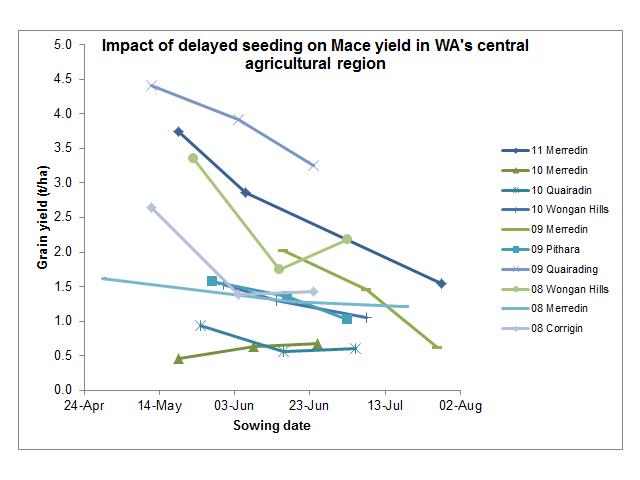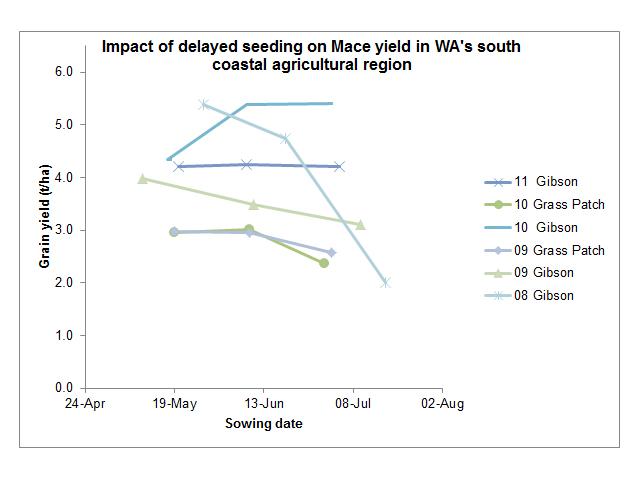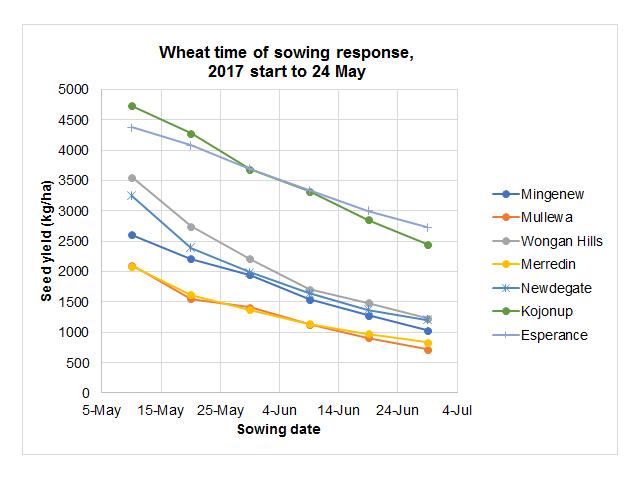Introduction
Variety choice, sowing time, stored moisture and growing season rainfall are factors which influence the yield potential of a wheat crop. Early sowing with an optimal variety can lengthen the growing season and deliver increased yields. Delayed seeding or emergence–delayed sowing will shorten the growing season, reducing yield potentials. However, wheat crops emerging in June can still give a good yield if the remainder of the season is suitable. This article draws on trial results (2006–2011) and uses APSIM modelling to assess the likely yield penalty of delayed sowing or emergence.
What we did
Research trials
The results from time of sowing trials, undertaken between 2008–2013 in Western Australia, have been collated to compare the impact of delayed sowing on yield. The analysis compared the yield of mid-to-late May sown crops with June sown crops. The average yield loss (kg/ha/day) for Mace wheat has been calculated for trials which included sown dates in the first to fourth weeks of June or July. The percentage yield loss is relative to the yield achieved with a May sowing.
The trials were grouped according to region. The northern agricultural region included trials from Badgingarra, Coorow, Mullewa and Mingenew. The central agricultural region included trials from Wongan Hills, Pithara, Merredin, Corrigin and Quairading. The Great Southern and Lakes district included trials from Katanning, Newdegate, Franklin and Kojonup. The south coastal agricultural region included trials from Gibson, Salmon Gums and Grass Patch.
The results from time of sowing trials in 2006 and 2007 in the northern agricultural region illustrate yield loss in very low rainfall seasons.
APSIM modelling
APSIM modelling was used to predict wheat yield response to sowing time at seven locations in Western Australia between 1976–2016. For each year of analysis, the meteorological data up to 24 May was replaced with 2017 observations. The median yield results are displayed by location. Assumption were: Mace wheat sown on 10 May, 20 May, 30 May, 9 June, 19 June, 29 June on a shallow sandy duplex (APSOIL database number 507) at Esperance, Kojonup, Newdegate, Merredin, Mullewa, Mingenew and Wongan Hills; in addition, 30kg N/ha applied as urea at sowing and 100kg N applied as urea 30 days after sowing (that is, a ‘luxury’ N rate to ensure no N deficiency).
What we found
Yield loss
Between 2007–2011, delayed emergence of wheat crops into June can result in a small yield gain or a significant yield loss of up to 48kg/ha/day compared to crops emerging in May (Table 1). Seasonal conditions such as frost, terminal drought or heat stress during the growing season will have an impact on these responses. Yield loss on the SCAR averaged 13kg/ha/day compared to 28, 23 and 26kg/ha/day in the central agricultural region, Great Southern and northern agricultural region, respectively, for the series of trials undertaken between 2008–2011. It is also important to note that these declines are compared to a mid- to late-May seeding, and doesn’t include analysis from earlier sowing times.
| Week sown | Yield loss NAR | No. of trials | Yield loss CAR | No. of trials | Yield loss GS | No. of trials | Yield loss SCAR | No. of trials |
|---|---|---|---|---|---|---|---|---|
| First week in June | 16 | 7 | 48 | 3 | 21 | 2 | - | - |
| Second week in June | 19 | 2 | 16 | 1 | 27 | 4 | -7 | 5 |
| Third week in June | 34 | 6 | 33 | 3 | 21 | 4 | 28 | 1 |
| Fourth week in June | - | - | 28 | 3 | 18 | 6 | 14 | 1 |
| July | - | - | 16 | 4 | 26 | 2 | 16 | 5 |
| Average yield loss | 26 | 15 | 28 | 14 | 23 | 18 | 13 | 12 |
Note: To calculate yield reduction (kg/ha) with delayed sowing, multiply the yield loss by the number days from a mid-late May sowing.
The APSIM modelling estimates yield loss over a wider range of seasons. Estimated yield losses with delayed sowing ranged from 14–60kg/ha/day depending on locations and sowing date (Table 2).
Predicted yield losses differed between the observed (Table 1) and predicted values (Table 2). These differences may be due to the assumptions used for the APSIM modelling, the grouping of time-of-sowing trials based on region or the date of the May sowing. However, the information provides a good indication of the range of yield losses which growers may observe if crops are emerging in June.
| Week sown | Mullewa | Mingenew | Wongan Hills | Merredin | Newdegate | Kojonup | Esperance |
|---|---|---|---|---|---|---|---|
| 30 May | 14 | 26 | 54 | 25 | 41 | 60 | 38 |
| 9 June | 21 | 33 | 52 | 24 | 37 | 48 | 37 |
| 19 June | 21 | 31 | 42 | 22 | 34 | 48 | 36 |
| 29 June | 21 | 29 | 38 | 20 | 30 | 46 | 34 |
| Average | 19 | 30 | 47 | 23 | 35 | 50 | 36 |
Yield potential
The impact of delayed seeding on yield potential differed between locations and seasons (Figure 1–4). In some years such 2009, there was no stored moisture and dry conditions in the central agricultural region compared to the south coastal agricultural region, which had significant stored moisture. In 2017 there are varying levels of moisture between districts. The value of stored moisture, assuming the crop can access it, will be higher yield potentials however this will decline as seeding or emergence is delayed in to June (Figure 1–4)




The crops yield potential will influence yield losses. In 2006 and 2007 yields were extremely low in some districts because of low rainfall and delayed seeding opportunities in to June. In the sowing time trials at Wongan Hills, Wyalkatchem yields ranged from 3–1.8t/ha with delayed sowing from mid-May to mid-July (Figure 5). This was a yield loss of 23kg/ha/day. In contrast, at Buntine, yield loss per day was low because the yields achieved were less than 0.5t/ha at all sowing times in a low rainfall year.

APSIM modelling for 2017 indicates significantly different yield potentials between locations in WA (Figure 6). The yield potential at each sowing time in Kojonup and Esperance are higher than the other locations. The yield potential of wheat crops emerging in June at Mullewa and Merredin are less than 1t/ha. When committing resources for your crops which are yet to emerge, consider its yield potential and the stored moisture in the profile.

Implications
- Crops emerging in June can have good yield, depending on location and seasonal conditions.
- Delayed sowing into June can have a significant impact on yield potential.
- Average yield losses of 26kg/ha/day (NAR), 28kg/ha/day (CAR), 23kg/ha/day (GS) and 13kg/ha/day (SCAR) were observed from date of sowing trials.
- Assess yield potential and the level of stored soil moisture before committing resources to late sown or emerging crops.
Acknowledgements
The financial support of growers through the GRDC was gratefully appreciated. Technical support provided through DPIRD was invaluable and appreciated. Grower groups provided access to research locations and communication opportunities. This enabled delivery of key messages to industry.
